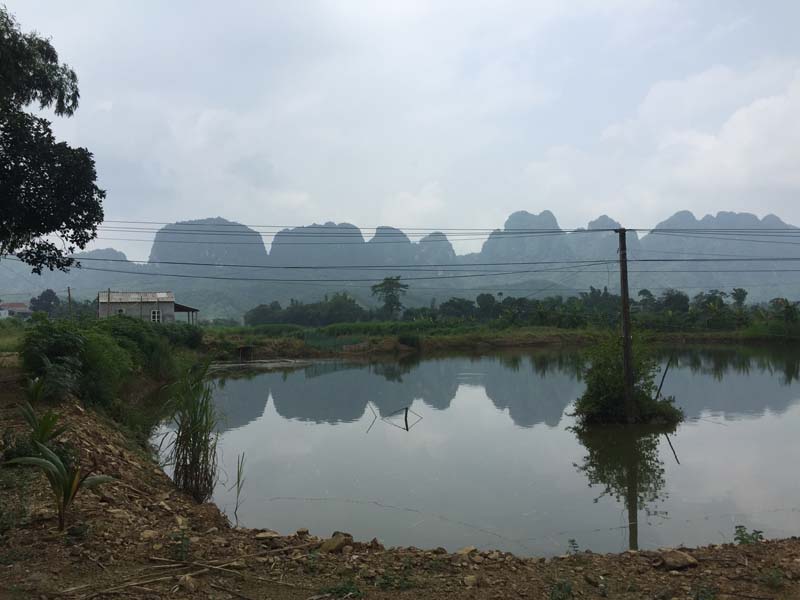
(HBO) – In the first half of 2018, the Party Committee of My Hoa commune, Kim Boi district (Hoa Binh province), issued two resolutions on natural resources management and environmental protection. However, machines have still dug up land in search of gold. In early August, authorised forces sent more than 200 people to examine, handle and detain equipment used for illegal gold mining in Kim Boi. This has shown that illegal gold mining in My Hoa has always been a "hot” issue.
An illegal gold
mining site in Dong Hoa 2 hamlet of My Hoa commune (Kim Boi district).
In June 2018, gold mining re-appeared here. Vice
Chairman of the My Hoa People’s Committee Ha Cong Tien said in July 2017, some
people purchased rice fields in Dong Hoa 1 and 2 hamlets to mine gold. They
took advantage of the Dong Hoa 2 Lake dredging project to stealthily bring
machines into the area and pretend to dredge the lake, but in fact, they dig up
soil to illegally mine gold. The area of destroyed land as a result of illegal
gold mining is approximately one hectare. When authorised forces took strong
actions and seized equipment, the activity temporarily eased from early August
2017 to June 2018.
In early June this year, to avoid being uncovered
by authorised forces and local residents, many households asked for the
communal administration’s permission to convert cultivation land into
aquaculture one, but they rented excavators and equipment to stealthily mine
gold. Particularly, they surrounded gold mining sites with brick and concrete
walls, black nets or elephant grass.
However, authorities realised abnormal signs and
made timely intervention. Those households were persuaded not to continue
illegal gold mining, but they refused. Therefore, the commune reported this
problem to the People’s Committee of Kim Boi district to devise solutions.
Facing the complicated illegal gold mining, on
August 11, authorised forces mobilised over 200 people to examine and deal with
illegal mining sites in My Hoa. They confiscated two excavators, over 100
metres of pipes and much equipment. Water was also released to fill illegal
mining holes and ponds. There are not any illegal mining equipment in the area
at present, Vice Chairman Tien said./.
The Department of Education and Training of Hoa Binh province held a conference on March 18 to review the performance of the "Safe and Happy School" Project and set out tasks for 2025. The project, funded by the Taiwan Fund for Children and Families (TFCF), aims to create a safe, inclusive, and supportive learning environment for students. The event saw the attendance of representatives from the TFCF and 26 beneficiary schools.
With over 70% of their workers being women, trade unions across industrial parks (IPs) in Hoa Binh have been actively safeguarding their legal rights and interests while implementing initiatives to improve their income and well-being.
In recent years, the Hoa Binh provincial General Hospital has continuously innovated itself and improved the quality of medical services to meet the increasing needs of local people. With substantial investments in infrastructure and modern equipment, along with a team of highly qualified doctors and nurses, the hospital has gradually established itself as one of the leading medical units in the Northwestern region and a trusted destination for healthcare for people inside and outside the province.
From mastering the fundamentals of programming to achieving national recognition, the Programming Club of the Le Van Tam Primary School (STAR LVT28) in Hoa Binh city has made remarkable strides in the field of robotics.
The Ho Chi Minh Communist Youth Union Committee and the Vietnam Youth Federation chapter of Hoa Binh province organised a programme on March 12 to launch the "Digital Literacy" movement and an online quiz on the resolutions of the Vietnam Youth Federation congresses at all levels, as well as the Politburo's Resolution No. 57-NQ/TW on breakthroughs in the development of science, technology, innovation, and national digital transformation.
As climate change grows more unpredictable, the development of production forests has become essential - not just for economic growth, but for safeguarding the environment and maintaining ecosystem balance. By boosting local incomes, curbing natural disasters, preventing soil erosion, and protecting water resources, these forests play a crucial role in sustainable development.



